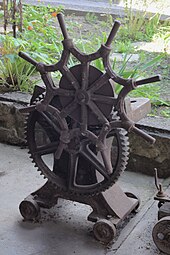tires

A tire is the part of the wheel that it rolls on. It sits on the circumference of the wheel and transfers the forces between the wheel and the road. The part of the tire that is in contact with the ground is called the tire contact patch , and the tread extends around the tire. The tire bears the wheel load ; When cornering, it also transmits the cornering force , and when the speed changes , it also transmits longitudinal forces ( acceleration force, also called braking force when opposite to the direction of travel). About liabilityOn the road, tires of non-rail vehicles usually have a tread made of rubber or other elastic material at the contact point between the wheel and the surface of the road . In rail-bound vehicles, the tire has a flange for lateral guidance ; when accelerating and especially when braking, the friction is increased by spreading sand .
Types
Iron tires
Iron tires made of steel are the oldest tires. They protected the traditional wooden wheels from wear and tear and hold the wooden wheel rim, the spokes and the hub together. For assembly, the tire is heated to red heat, the diameter increasing due to the thermal expansion and then cooled with water after mounting. If you loosen the tire, broken parts can be easily replaced. A similar technique is used by the cooper , who puts on barrel hoops during barrel manufacture . They hold the barrel staves together and are made of metal; earlier the hoop cutter made wooden barrel hoops. The technique has been known since ancient times.Flat tires used to be common; the iron tire also wears out. There was a repair infrastructure along the traffic routes; in every larger village there were blacksmiths and wagons or wheelwrights (which is why Schmidt and Wagner are common family names).
The tires of the railway wheels are also made of steel .
Solid rubber tires
Solid rubber tires were the most comfortable tire before the invention of pneumatic tires and were still used afterwards, for example on trucks. They can still be found on wheels that run on relatively smooth surfaces (tea trolleys, forklifts ). Elastic tires are not only made from rubber, but also from other elastic plastics or, since the 2000s, as Tweel (combination of wheel and tire).
tire
A pneumatic tire (also called tires), consist of a fabric or scrim of fibers of the carcass , which is glued with rubber and jacketed and contain the pressurized air or other gases attenuate the road shock (tire suspension). The air is held in a tube or, in the case of tubeless tires, trapped between the tire and the rim. Depending on the type of carcass, a distinction is made between diagonal and radial tires .
Tires are named after their intended use for various means of transport. There are, for example, car tires , commercial vehicle tires , motorcycle tires , agricultural tires , OTR tires (earthmover), forklift tires , forestry tires , industrial tires , bicycle tires and aircraft tires .
Some tires are designed separately for steering axles or drive axles (see car tires ).
After use, tires become old tires . Old tires with an undamaged casing can be retreaded and reused.
history
The tire in its current form was made possible by several inventions made relatively quickly one after the other :
- The American Charles Goodyear applied for a patent for the vulcanization of rubber in 1844 .
- In 1845 the Scot Thomson applied for a patent for a pneumatic tire with a vulcanized tube for vehicles , but found no buyers for his idea, although the tire had been successfully tested in 1847. Thomson used it for some of the street locomotives he developed .
- In 1888 the Scot John Dunlop patented a simple pneumatic bicycle tire.
- In 1890 Charles Kingston Welch received the patent on a clincher tire and William Erskine Bartlett the patent on a bulbous strip.
- In 1895, the French Michelin achieved his economic breakthrough with the introduction of a pneumatic tire with a tube .
- In 1903, Friedrich Veith began to introduce tires in standard sizes and to implement correspondingly standardized rims.
- In 1904, Continental was the first company in the world to develop "tread tires for automobiles".
The resulting tire manufacturers Goodyear , Dunlop , Continental and Michelin developed into world-famous brands today . The invention of the pneumatic tire meant that the high wheels disappeared from the market within a few years.
Noise limit values and rolling resistance coefficients
Limit values for rolling noise and rolling resistance coefficients according to EU Regulation No. 661/2009:
| great | Tire width in mm | Noise limit value in dB (A) | Rolling resistance coefficient (max.) In kg / t |
|---|---|---|---|
| C1a (car) | to 185 | 70 | 10.5 |
| C1b (car) | 185-215 | 71 | 10.5 |
| C1C (car) | 215-245 | 71 | 10.5 |
| C1d (car) | 245-275 | 72 | 10.5 |
| C1e (car) | > 275 | 74 | 10.5 |
| C2 (light commercial vehicles) | 72 * (73) | 9.0 | |
| C3 (heavy commercial vehicles) | 73 * (75) | 6.5 |
- Normal tires, traction tires ()
Web links
- 125 years of air-rubber tires: 125 years ago John Boyd Dunlop invented the air-filled tire - for the second time. June 30, 2013, www.Stern.de
Individual evidence
- ↑ Grace's Guide: Robert William Thomson. (accessed on August 19, 2017)
- ^ History of the high bikes
- ↑ REGULATION (EC) No. 661/2009 (PDF)




